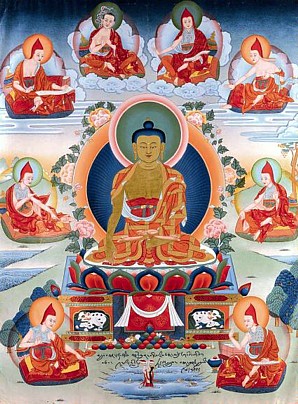Two Supreme Ones: Difference between revisions
Jump to navigation
Jump to search
No edit summary |
mNo edit summary |
||
| Line 1: | Line 1: | ||
[[Image:Buddha and 6 Ornaments 2 Supreme.jpg|frame|Buddha with the Six Ornaments and Two Supreme Ones]] | [[Image:Buddha and 6 Ornaments 2 Supreme.jpg|frame|Buddha with the Six Ornaments and Two Supreme Ones]] | ||
'''Two Supreme Ones''' ([[ | '''Two Supreme Ones''' ([[Wyl.]]'' mchog gnyis'') — | ||
#According to one way of counting the [[Six Ornaments]] and Two Supreme Ones, this refers to [[Gunaprabha]] and [[Shakyaprabha]]. | |||
#According to another tradition, this refers to [[Nagarjuna]], the founder of the tradition of [[Profound View]] and [[Asanga]], the founder of the tradition of [[Vast Conduct]]. | |||
[[Category:Historical Masters]] | [[Category:Historical Masters]] | ||
[[Category:Indian Masters]] | |||
[[Category:Enumerations]] | [[Category:Enumerations]] | ||
Revision as of 12:18, 13 November 2008

Two Supreme Ones (Wyl. mchog gnyis) —
- According to one way of counting the Six Ornaments and Two Supreme Ones, this refers to Gunaprabha and Shakyaprabha.
- According to another tradition, this refers to Nagarjuna, the founder of the tradition of Profound View and Asanga, the founder of the tradition of Vast Conduct.